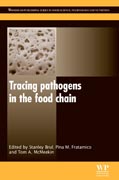
Successful methods for the detection and investigation of outbreaks of foodborne disease are essential for ensuring consumer safety. Increased understanding of the transmission of pathogens in food chains will also assist efforts to safeguard public health. Tracing pathogens in the food chain reviews key aspects of the surveillance, analysis and spread of foodborne pathogens at different stages of industrial food production and processing. Part one provides an introduction to foodborne pathogen surveillance, outbreak investigation and control. Part two concentrates on subtyping of foodborne pathogens, with chapters on phenoytypic subtyping and pulsed-field gel electrophoresis, as well as emerging methods. The vital topics of method validation and quality assurance are also covered. The focus in Part three is on particular techniques for the surveillance and study of pathogens, such as proteinbased analysis, ribotyping andcomparative genomics. Finally, Part four focuses on tracing pathogens in specific food chains, such as red meat and game, dairy, fish and shellfish. With its distinguished editors and international team of contributors, Tracing pathogens in the food chain is a standard reference for researchers, public health experts and food industry professionals concerned with the study and control of foodborne disease. Stanley Brul is Professor of Molecular Biology at the University of Amsterdam. INDICE: Part 1 Foodborne pathogen surveillance and outbreak investigation:Surveillance for foodborne pathogens in humans; Systems for real-time, linkedfoodborne pathogen surveillance; Detection, investigation and control of outbreaks of foodborne disease; Attributing the burden of foodborne disease to specific sources of infection; Determining the economic costs and global burden of foodborne disease. Part 2 Subtyping of foodborne pathogens: Phenoytypic subtyping of foodborne pathogens; Pulsed-field gel electrophoresis and other commonly used molecular methods for subtyping of foodborne bacteria; Emerging methods for foodborne bacterial subtyping; Development, validation and quality assurance of methods for subtyping of foodborne pathogens. Part 3 Molecular methods, genomics and other emerging approaches in the surveillance and study of foodborne pathogens: Sample preparation for the detection of foodborne pathogens by molecular biological methods; A comparison of molecular technologies and genomotyping for tracing and strain characterization of Campylobacter isolates; Investigating foodborne pathogens using comparative genomics; Protein-based analysis and other new and emerging non-nucleic acid based methods for tracing and investigating food-borne pathogens; Virulotyping of foodborne pathogens; Using ribotyping to trace foodborne aerobic sporeforming bacteria in the factory: a case study; Biotracing: a novel concept in food safety integrating microbiology knowledge, complex systems approaches and probabilistic modeling. Part 4Tracing pathogens in particular food chains: Tracing pathogens in red meat and game production chains and at the abattoir; Tracing pathogens in fish production chains; Tracing pathogens in poultry and egg production and at the abattoir; Tracing zoonotic pathogens in dairy production; Tracing pathogens in molluscan shellfish production chains; Tracing pathogens in fruit and vegetable production chains.
- ISBN: 978-1-84569-496-8
- Editorial: Woodhead
- Encuadernacion: Cartoné
- Páginas: 700
- Fecha Publicación: 01/09/2010
- Nº Volúmenes: 1
- Idioma: Inglés
